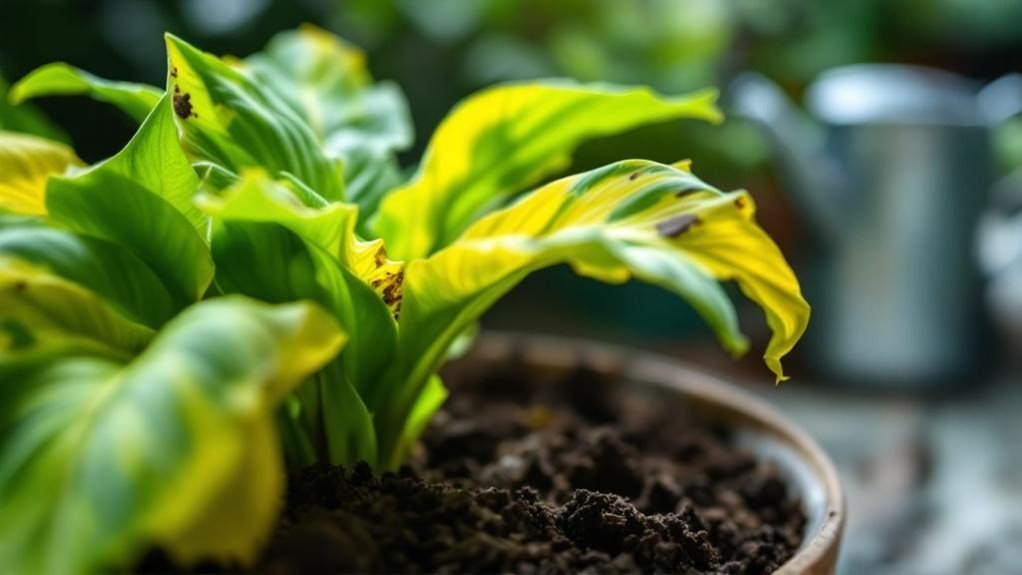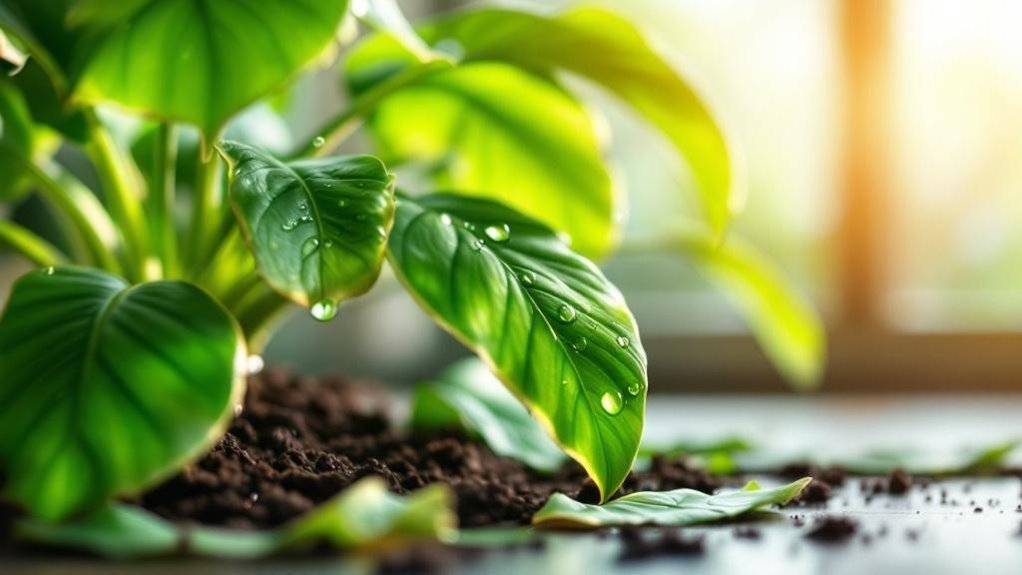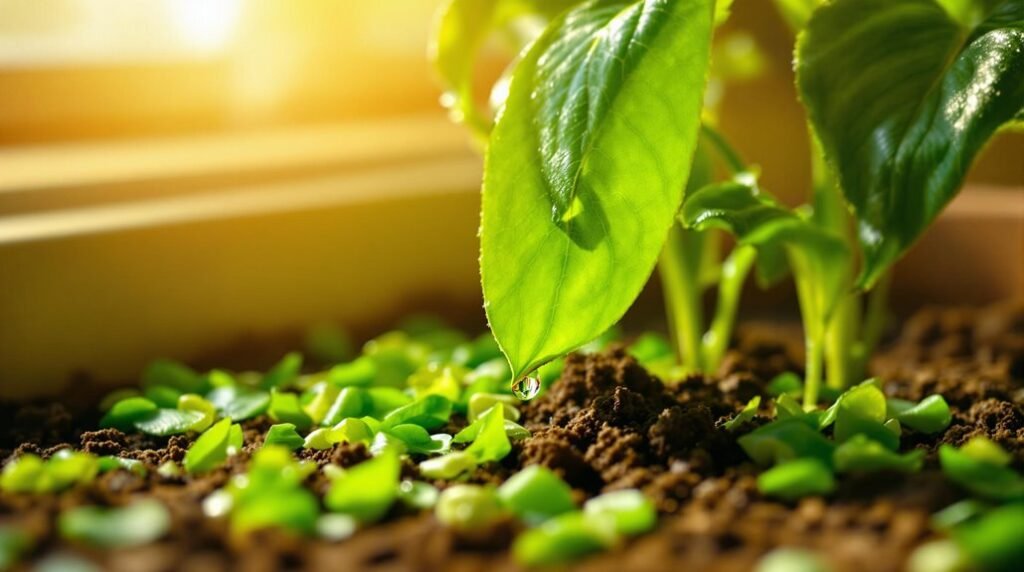It’s funny how you notice your plant dropping leaves just after you’ve moved it to a new spot or changed your watering routine. When leaves fall suddenly, it’s usually a sign that something’s off—whether it’s stress, pests, or something less obvious. Understanding what’s behind this reaction can help you take the right steps to nurse your plant back to health. Let’s explore what might be causing your plant’s sudden leaf loss.
Understanding Plant Shock and Leaf Drop
When your plant faces sudden changes in environment—like a new location, different lighting, or temperature shifts—it can go into shock and drop its leaves.
Sudden environment changes like new spots or lighting can shock your plant, causing leaf drop.
This plant shock happens because abrupt changes stress your plant, causing leaf drop as it struggles to adjust. Sensitive plants, such as fiddle leaf figs and rubber plants, are especially vulnerable during these changes.
If you repot your plant, transplant shock can also trigger leaf loss, but you can ease this by using products like Pennington Plant Starter to help the roots recover.
Remember, your plant may take days or even weeks to acclimate, so keep an eye on its progress.
Gradual changes minimize shock, protecting your plant from unnecessary leaf drop and helping it thrive in its new environment.
Recognizing Improper Watering as a Cause
Besides environmental changes, improper watering ranks among the top reasons plants drop leaves. If you notice yellow leaves or dropping leaves, check your plant’s soil moisture.
Overwatering can cause root rot, making leaves soft, black, and droopy. Underwatering, on the other hand, leads to dry, brown, and crispy leaves.
To prevent this, use a moisture meter or simply stick your finger about two inches into the soil. Only water when this top layer feels dry.
Adjust your watering habits based on the plant’s needs and surrounding conditions. By maintaining the right soil moisture balance, you can stop leaf drop and keep your plant healthy and thriving.
Identifying Nutritional Deficiencies in Plants

Although leaf drop can stem from various causes, nutritional deficiencies often play a key role you shouldn’t overlook. When your plants drop leaves due to lack of nutrients, you’ll often notice yellow or brown discoloration.
For example, nitrogen deficiency causes older leaves to yellow, while magnesium deficiency leads to yellowing between green veins. These symptoms signal your plant isn’t getting what it needs.
Overfeeding can also cause leaves to drop due to root damage and toxicity, so balance is fundamental. To prevent these issues, apply quality plant food like Pennington Rejuvenate regularly. Additionally, consider using Dr. Earth Organic 5 fertilizer, which boosts nutrient uptake effectively with beneficial microbes, helping your plants stay healthy and avoid leaf drop caused by nutritional deficiencies.
Balance is key—use quality plant food like Pennington Rejuvenate to avoid root damage and leaf drop.
Supplements like Epsom Salt and Alaska Fish Fertilizer provide vital magnesium and trace elements, helping your plants stay healthy and avoid leaf drop caused by nutritional deficiencies.
Detecting Insect Pests on Your Plants
Nutrient problems aren’t the only reason your plants might be dropping leaves—pest infestations can cause similar symptoms.
To detect insect pests early, inspect the undersides of leaves regularly for signs of infestation like wilting, curling, or discoloration. Look closely for leaf damage such as holes, sticky residue, or visible pests like aphids and spider mites.
Fallen leaves can also reveal pest activity if you find damage or debris. Treat infestations promptly with broad-spectrum insecticides, such as Sevin, to prevent further harm.
- Check leaf undersides daily for pests
- Identify holes, discoloration, or curling
- Spot sticky honeydew indicating sap-feeders
- Examine fallen leaves for pest signs
- Use appropriate insecticides early to control infestations
Diagnosing Plant Diseases Leading to Leaf Loss

When you notice your plant’s leaves turning yellow, brown, or developing unusual spots, it often signals a disease that could lead to leaf drop.
Yellow, brown, or spotted leaves often indicate a disease causing your plant’s leaves to drop.
Plant diseases, especially fungal infections, show clear signs like discoloration and white growths on leaves. These symptoms warn you before the leaves fall off.
To diagnose, regularly check your plant for pests, holes, or debris, as insect infestations can worsen leaf drop alongside diseases. Acting fast is key—treat affected plants with fungicides like Daconil to stop disease spread.
Also, remember that nutrient deficiencies cause yellowing leaves, so keep your plants well-fertilized to maintain their health.
Effects of Sudden Environmental Changes on Leaves
If you suddenly move your plant or change its light exposure, you might notice it dropping leaves as it goes into shock. Sudden environmental changes can overwhelm your plant, causing leaf drop as it tries to adjust.
Sensitive species like fiddle leaf figs react strongly to shifts in temperature fluctuations or humidity. To help your plant recover, avoid abrupt changes and introduce new conditions gradually.
Here’s what you should watch for:
- Leaf drop triggered by sudden environmental changes
- Stress responses to temperature fluctuations
- Vulnerability of sensitive plants like rubber plants
- Importance of gradual acclimation to new surroundings
- Adjusting temperature and humidity to reduce stress
Impact of Light Conditions on Leaf Retention
Although plants need light to thrive, insufficient exposure often causes them to drop leaves to conserve energy. When light conditions are poor, plants like fiddle leaf figs and weeping ficus trees may show yellowing leaves before leaf drop occurs.
Sudden changes in light—moving your plant to a much darker or brighter spot—can stress it, triggering immediate leaf drop as it struggles to adapt. To help your plant retain its leaves, monitor light levels closely and adjust its position accordingly.
Make sure it gets enough indirect sunlight without harsh direct rays that could damage foliage. Using supplemental grow lights or placing plants nearer to windows can prevent leaf drop caused by inadequate light conditions, keeping your greenery healthy and vibrant.
How Temperature and Draughts Affect Plant Health
Because plants rely on stable temperatures to stay healthy, sudden changes can stress them and cause leaves to drop.
Temperature changes confuse your plant’s systems, triggering leaf drop as they struggle to adapt. Draughts from windows, vents, or air conditioning worsen this stress by exposing plants to inconsistent airflows.
You should keep your plants in warm, stable environments to prevent this. Here are some tips to protect your plant from temperature and draught-related stress:
- Avoid placing plants near open windows or doors.
- Keep them away from heating and cooling vents.
- Monitor room temperature to guarantee it stays consistent.
- Move tropical plants to warmer spots with stable air.
- Watch for quick leaf drop as a sign of temperature stress.
Managing temperature changes and draughts helps your plants stay vibrant and healthy.
Addressing Humidity and Soil Moisture Issues
Temperature and airflow aren’t the only factors that affect your Money Tree’s leaf health; humidity and soil moisture play a big role too. Low humidity can cause brown or yellow leaves and lead to leaf drop. You can boost humidity by misting or using a pebble tray with water. Soil moisture is just as essential—water when about 50% of the soil is dry. Check moisture with your finger or a wooden stick. Avoid letting soil dry out completely to prevent root damage. If it’s bone dry, soak the pot to rehydrate, but don’t change moisture levels too fast to avoid stress. Using a soil pH meter can help you monitor moisture levels more accurately.
| Issue | Solution |
|---|---|
| Low humidity | Misting or pebble tray |
| Overwatering | Let soil dry 50% between watering |
| Dry soil | Soak pot to rehydrate |
| Leaf drop | Adjust humidity and soil moisture |
| Checking moisture | Use finger or wooden stick |
Tips for Helping Your Plant Recover From Leaf Drop
When your Money Tree starts dropping leaves, you should carefully assess its environment and make gradual adjustments to light, humidity, and temperature to prevent further stress.
Sudden changes in temperature or light can worsen leaf loss, so acclimate your plant slowly. Monitor soil moisture levels to avoid overwatering or underwatering, both common causes of leaf drop. Good plant care also includes checking for pests and providing proper nutrition.
Here are tips to help your plant recover:
- Gradually adjust to new lighting and temperature conditions
- Keep soil moisture levels consistent, neither too wet nor dry
- Use quality fertilizers to replenish nutrients
- Inspect regularly for pests or diseases and treat promptly
- Place the plant in a well-lit spot for ideal energy production
Frequently Asked Questions
Can a Plant Recover From Losing Leaves?
Yes, your plant can recover from losing leaves if you adjust its care. Focus on proper light, watering, and humidity, check roots, and be patient. New growth means your plant’s bouncing back strong.
How Do You Fix Droopy Plant Leaves?
When your plant’s leaves droop like wilted sails, you need to water it just right—neither drowning nor deserting—adjust light, check for pests, and boost humidity. Treat it gently, and watch it lift its leaves proudly again.
What Does It Mean When a Leaf Falls off a Plant?
When a leaf falls off your plant, it’s usually a sign of stress from changes like watering issues, pests, or environmental shifts. It’s your cue to check care routines and adjust light, water, or nutrients accordingly.
What Does It Mean When a Plant’s Leaves Are Down?
When your plant’s leaves droop, it usually means it’s stressed from too much or too little water, lack of light, or sudden environmental changes. Check its watering routine, lighting, and surroundings to help it recover quickly.
Final Thoughts
If your plant suddenly drops leaves, don’t panic—it’s often a sign it needs your attention, not that it’s doomed. You might think it’s too late to help, but by checking watering habits, pests, and environmental factors, you can often reverse the damage. Consistent care and quick action can bring your plant back to health. Remember, plants are resilient, and with patience, they’ll recover and thrive again.
